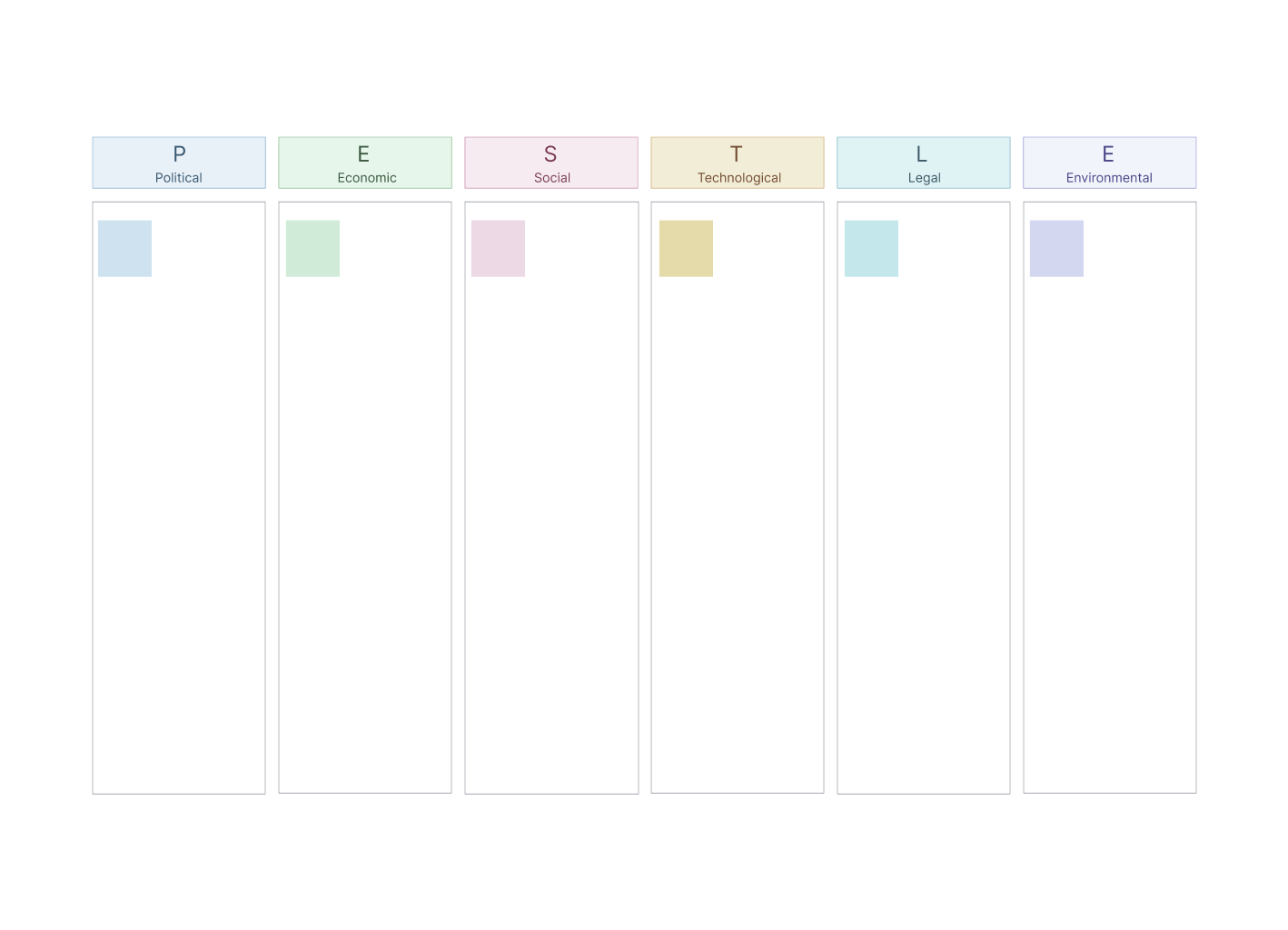Understanding the external environment is crucial for any business aiming to succeed and grow in today’s fast-changing world. A PESTEL analysis tool is a simple yet powerful tool that helps organizations identify and evaluate key external factors—political, economic, social, technological, environmental, and legal—that can impact their operations and strategy.
What Is a PESTLE Analysis Tool
PESTLE analysis is a strategic tool that helps businesses understand the external factors that could impact their operations and decision-making. The name “PESTLE” stands for Political, Economic, Social, Technological, Legal, and Environmental factors. These are broad categories that represent different areas of influence in the world outside the business. By analyzing these areas, businesses can get a clearer picture of what’s happening around them, spot risks early, and uncover new opportunities.
PESTEL Analysis Factors
PESTEL analysis tool looks at six key external factors that can influence a business.
Political factors: These involve government actions like tax policies, trade rules, labor laws, and political stability that affect business operations. Changes in government or regulations can impact what companies can do or sell.
Economic factors: These include inflation, interest rates, economic growth, unemployment, and consumer spending, all of which influence business performance and planning.
Social factors: Social trends like demographics, education, lifestyles, and cultural values shape customer needs and expectations, helping businesses connect with their audience.
Technological factors: Innovation, automation, and access to new technologies can disrupt industries, improve efficiency, or create new opportunities for businesses.
Environmental factors: Issues like climate change, sustainability, resource availability, and environmental laws impact how companies operate and manage risks.
Legal factors: Laws on employment, consumer protection, data privacy, and safety affect business practices and can present risks or opportunities.
How to Conduct a PESTEL Analysis
Step 1: Define the scope and objective of your analysis
Before jumping into research, clarify why you’re doing the analysis and what you’re analyzing. Are you:
- Entering a new geographic market?
- Launching a product or service?
- Planning a merger or expansion?
- Reviewing long-term strategy?
Also decide on the geographic scope. For example, a company operating globally will need to examine political and legal factors in multiple countries, while a local business may focus only on national or regional conditions.
Tip: A clearly defined purpose helps you stay focused and gather only relevant data.
Step 2: Research each of the six PESTEL categories
Now look at each of the six categories. Take your time to gather accurate and up-to-date information from reliable sources like;
- Government websites and policy papers
- Central banks and economic research centers
- News outlets (e.g., Bloomberg, Reuters, BBC)
- Industry associations and market research firms
- Academic articles, whitepapers, and NGO reports
Now let’s break down what to look for under each category.
- Political: Check for things like government stability, upcoming elections, trade restrictions, or new laws that may impact your business.
- Economic: Look into interest rates, inflation, consumer spending, unemployment, and economic growth in your region or target market.
- Social: Study population trends, education levels, cultural values, lifestyles, and attitudes toward your type of product or service.
- Technological: Identify trends in innovation, automation, digital tools, and any technology that might change your industry or processes.
- Environmental: Look at climate issues, sustainability practices, environmental regulations, and how eco-conscious your customers are.
- Legal: Understand the laws that affect your business, like labor laws, data protection, health and safety, and product regulations.
Step 3: Filter and prioritize key factors
Once you’ve gathered the data, narrow it down to the most relevant factors for your business or project. Consider:
- Level of impact: Will this factor significantly affect operations, customers, or profits?
- Likelihood: Is this a high-probability change or a distant possibility?
- Timeframe: Will the impact be short-term, medium-term, or long-term?
Use a scoring system if needed—for example, assigning a score of 1–5 for both impact and likelihood.
Step 4: Analyze and interpret the information
This is where raw data turns into insights. For each selected factor, ask:
- How exactly could this affect our organization?
- Will this lead to a new opportunity or pose a threat?
- What strategic response or action might we need to take?
You can apply SWOT analysis alongside PESTEL to map external factors to your internal strengths and weaknesses.
Step 5: Organize your findings in a structured format
Create a clear, visual summary using a table, matrix, or slide. This is helpful for presentations and strategic discussions.
Example PESTEL Table:
| Factor | Key Issue | Impact | Action Needed |
| Political | New trade restrictions on electronics | High (cost increase) | Explore alternative suppliers |
| Economic | Rising interest rates | Medium | Re-evaluate financing strategy |
| Social | Shift toward remote work | High (changing demand) | Launch home-office product line |
| Technological | Growth in AI adoption | High | Invest in AI-powered tools |
| Environmental | Carbon tax laws in EU | Medium | Assess supply chain emissions |
| Legal | New consumer privacy rules | High | Update privacy policy and systems |
Step 6: Use the results to support strategic planning
Finally, integrate the findings into your broader business planning. This could help with:
- Market entry decisions
- Product development and positioning
- Risk management
- Competitive strategy
- Compliance and sustainability goals
A good PESTEL analysis tool allows businesses to make informed, forward-thinking decisions and stay adaptable in a rapidly changing world.
PESTEL Analysis Templates and Practical Examples of PESTEL Analysis
Simply choose the PESTEL model template that fits your needs and begin organizing your external factors right away.
AI PESTLE Analysis Template
PESTLE Analysis Template
PESTLE Analysis Example
Here are some examples of PESTEL analysis for different industries and well-known companies.
1. PESTEL analysis example for Tesla (automotive industry)
- Political: Benefits from government incentives for electric vehicles but faces risks from changing import tariffs, especially between the U.S. and China.
- Economic: Rising raw material costs and economic slowdowns affect production and sales.
- Social: Growing concern for climate change boosts demand for electric vehicles.
- Technological: Leads in battery innovation, autonomous driving, and software updates.
- Environmental: Strict emissions laws increase demand for Tesla’s zero-emission cars.
- Legal: Faces challenges with data privacy, workplace safety, and varying vehicle regulations worldwide.
2. PESTEL analysis example for Starbucks (food & beverage industry)
- Political: Must comply with local labor laws, taxes, and navigate trade restrictions affecting coffee sourcing.
- Economic: Inflation and rising commodity prices increase costs; currency fluctuations impact revenue.
- Social: Growing demand for ethical, healthy, and sustainable products; Starbucks promotes recycling and ethical sourcing.
- Technological: Uses apps, loyalty programs, mobile ordering, and cashless payments to enhance customer experience.
- Environmental: Focuses on reducing plastic use, offering plant-based options, and tracking emissions.
3. PESTEL analysis example for Amazon (E-commerce/technology industry)
- Political: Influenced by tax, trade, and antitrust laws; faces political scrutiny over market dominance.
- Economic: Economic downturns boost demand for affordable online shopping, but rising wages and logistics costs hurt profits.
- Social: Online shopping grows; consumers want fast delivery; Amazon faces criticism over worker conditions.
- Technological: Invests in automation, AI, and cloud services (AWS) to stay competitive.
- Environmental: Criticized for packaging waste and emissions; aims for carbon neutrality by 2040.
- Legal: Must follow labor, data privacy, and trade laws; faces antitrust lawsuits and issues with third-party sellers.
4. PESTEL analysis example for Coca-Cola (beverage industry)
- Political: Affected by food and beverage taxes; relies on political stability with bottling partners.
- Economic: Recessions reduce premium drink sales, but a diverse portfolio helps reach various markets.
- Social: Growing health awareness leads to more zero-sugar drinks and water products.
- Technological: Uses advanced manufacturing and AI for forecasting and engagement.
- Environmental: Faces criticism for plastic and water use; focusing on sustainable packaging and water efforts.
- Legal: Complies with food labeling, advertising, and recycling laws worldwide.
How to Use Creately to Do a PESTEL Analysis
Creately makes doing a PESTEL analysis faster and smarter by combining AI-powered tools with an easy-to-use visual workspace and strong collaboration features. Whether working alone or with a team, you can start with customizable templates tailored to your industry, then organize and highlight key factors using a simple drag-and-drop interface.
Creately AI helps generate relevant political, economic, social, technological, environmental, and legal factors based on your business context and even supports exploring different scenarios. Teams can collaborate in real time, adding comments, notes, and attachments for deeper insights without switching tools. Plus, you can turn your analysis into actionable plans by linking it to Kanban boards, track versions over time, and easily export or present your findings to stakeholders—all in one platform.
References
Buye, R. (2021). Critical examination of the PESTEL Analysis Model. [online] Research Gate. Available at: https://www.researchgate.net/publication/349506325_Critical_examination_of_the_PESTEL_Analysis_Model.
International Journal of Advanced Research. (2020). Article Detail - International Journal of Advanced Research. [online] Available at: https://www.journalijar.com/article/52427/pestle-analysis/.
Washington State University (2025). Industry Research: PESTEL Analysis. [online] Washington State University. Available at: https://libguides.libraries.wsu.edu/c.php?g=294263&p=4358409.
Advantages: Disadvantages:FAQs about PESTEL Analysis Tool
How is PESTEL different from SWOT analysis?
What are common mistakes when doing a PESTEL analysis?
When should I use a PESTEL analysis?
What are the advantages and disadvantages of PESTEL analysis?
What is the difference between PESTEL and PEST analysis?
What role does environmental analysis play in PESTEL?








